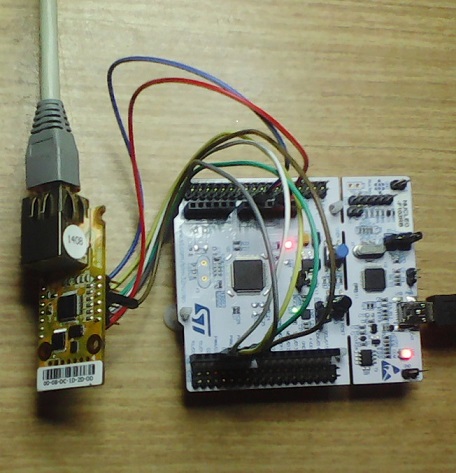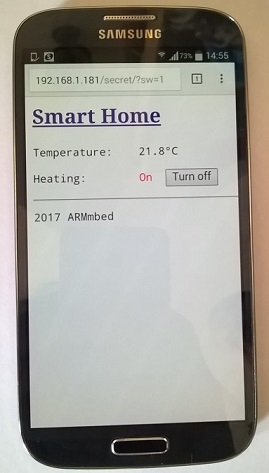HTTP Server serving a simple webpage which enables to remotely turn LED1 on/off. Compile, download, run and type 'IP_address/secret/' (don't forget the last '/') into your web browser and hit ENTER.
Dependencies: W5500Interface mbed
Turn LED1, or other digital output, on/off using a web browser.
In this example we create a HTTP server that will serve a simple Web page to remotely turn LED1, or other digital output on the mbed board, on/off by using a web browser. A WIZ550io module or W5500 Network-Shielld is used to assure connection between the mbed module and the Ethernet network (Internet).
Needed parts:
- mbed board
- WIZ550io module or W5500 Network-Shield
- Wires
- Web browser (Internet Explorer, Safari, Firefox, Chrome ...) running on Windows, Mac, Linux, iPhone or Android device.
 |  |
The project was inspired by the Tuxgraphics Web Switch. Thank you Guido!
NOTE:
- For a Web Switch using an ENC28J60 Ethernet module see WebSwitch_ENC28J60
- For a Web Switch using mbed's built in Ethernet PHY see WebSwitch_mbed-dev or WebSwitch_mbed-os
main.cpp
- Committer:
- hudakz
- Date:
- 2017-05-01
- Revision:
- 6:3d74cb156c5c
- Parent:
- 5:458d9d7b5c1b
File content as of revision 6:3d74cb156c5c:
/*
* In this example LED1 on the mbed board is turned on/off using a web browser.
* However, you can easily modify the project to remotely switch on/off any external device.
* The HTTP server is built from an mbed board and a WIZ550io board.
* The example is based on the Tuxgraphics Web Switch <http://www.tuxgraphics.org/>.
* For more details see <https://developer.mbed.org/users/hudakz/code/WebSwitch_WIZ550io/wiki/Homepage>
* Thanks to Jozsef Voros it works now also with the W5500 modules without a built-in MAC
* See below how to enable that.
*/
#include "mbed.h"
#include "EthernetInterface.h"
#include <string>
using namespace std;
const int OFF = 0;
const int ON = 1;
Serial serial(USBTX, USBRX);
#if defined(TARGET_LPC1768)
EthernetInterface eth(p11, p12, p13, p8, p14); // MOSI, MISO, SCK, CS, RESET
#elif defined(TARGET_LPC11U24)
EthernetInterface eth(P16, P15, P13, P17, P18); // MOSI, MISO, SCK, CS, RESET
#elif defined(TARGET_NUCLEO_F103RB) || defined(TARGET_NUCLEO_L152RE) || defined(TARGET_NUCLEO_F030R8) \
|| defined(TARGET_NUCLEO_F401RE) || defined(TARGET_NUCLEO_F302R8) || defined(TARGET_NUCLEO_L053R8) \
|| defined(TARGET_NUCLEO_F411RE) || defined(TARGET_NUCLEO_F334R8) || defined(TARGET_NUCLEO_F072RB) \
|| defined(TARGET_NUCLEO_F091RC) || defined(TARGET_NUCLEO_F303RE) || defined(TARGET_NUCLEO_F070RB) \
|| defined(TARGET_KL25Z ) || defined(TARGET_KL46Z) || defined(TARGET_K64F) || defined(TARGET_KL05Z) \
|| defined(TARGET_K20D50M) || defined(TARGET_K22F) \
|| defined(TARGET_NRF51822) \
|| defined(TARGET_RZ_A1H)
EthernetInterface eth(D4, D5, D3, D6, D7); // MOSI, MISO, SCK, CS, RESET
// If your board/plaform is not present yet then uncomment
// the following two lines and replace modify as appropriate.
//#elif defined(TARGET_YOUR_BOARD)
//EthernetInterface eth(SPI_MOSI, SPI_MISO, SPI_SCK, SPI_CS, RESET); // MOSI, MISO, SCK, CS, RESET
#endif
// Note:
// If it happends that any of the SPI_MOSI, SPI_MISO, SPI_SCK, SPI_CS or RESET pins collide with LED1 pin
// then either use different SPI port (if available on the board) and change the pin names
// in the constructor spi(...) accordingly or instead of using LED1 pin, select
// a free pin (not used by SPI port) and connect to it an external LED which is connected
// to a 220 Ohm resitor that is connected to the groud.
// In the second case remember to replace LED1 in sw(LED1) constructor (see below).
// IP address must be also unique and compatible with your network. Change as appropriate.
// If instead of WIZ550io you'd like to use a W5500 module without a built-in MAC please uncommend the following line
//#define W5500 1
#if defined(W5500)
// The MAC number must be unique within the connected network. Modify as appropriate.
uint8_t MY_MAC[6] = { 0x00, 0x01, 0x02, 0x03, 0x04, 0x05 };
#endif
const char MY_IP[] = "192.168.1.181";
const char MY_NETMASK[] = "255.255.255.0";
const char MY_GATEWAY[] = "192.168.1.1";
int MY_PORT = 80;
TCPSocketServer server;
TCPSocketConnection client;
bool serverIsListening = false;
DigitalOut sw(LED1); // Change LED1 to a pin of your choice.
// However, make sure that it does not collide with any of the SPI pins
float roomTemp = 21.8; // A temperature sensor output
const string PASSWORD = "secret"; // change as you like
const string HTTP_OK = "HTTP/1.0 200 OK";
const string MOVED_PERM = "HTTP/1.0 301 Moved Permanently\r\nLocation: ";
const string UNAUTHORIZED = "HTTP/1.0 401 Unauthorized";
string httpHeader; // HTTP header
string httpContent; // HTTP content
/**
* @brief Analyses the received URL
* @note The string passed to this function will look like this:
* GET /password HTTP/1.....
* GET /password/ HTTP/1.....
* GET /password/?sw=1 HTTP/1.....
* GET /password/?sw=0 HTTP/1.....
* @param url URL string
* @retval -1 invalid password
* -2 no command given but password valid
* -3 just refresh page
* 0 switch off
* 1 switch on
*/
int8_t analyseURL(string& url) {
if(url.substr(5, PASSWORD.size()) != PASSWORD)
return(-1);
uint8_t pos = 5 + PASSWORD.size();
if(url.substr(pos, 1) == " ")
return(-2);
if(url.substr(pos++, 1) != "/")
return(-1);
string cmd(url.substr(pos, 5));
if(cmd == "?sw=0")
return(OFF);
if(cmd == "?sw=1")
return(ON);
return(-3);
}
/**
* @brief
* @note
* @param
* @retval
*/
string& movedPermanently(uint8_t flag) {
if(flag == 1)
httpContent = "/" + PASSWORD + "/";
else
httpContent = "";
httpContent += "<h1>301 Moved Permanently</h1>\r\n";
return(httpContent);
}
/**
* @brief
* @note
* @param
* @retval
*/
string& showWebPage(uint8_t status) {
char roomTempStr[5];
//roomTemp = ds1820.read();
sprintf(roomTempStr, "%3.1f", roomTemp);
httpContent = "<h2><a href=\".\" title=\"Click to refresh the page\">Smart Home</a></h2>";
httpContent += "<pre>Temperature:\t" + string(roomTempStr) + "°C\r\n</pre>";
if(status == ON) {
httpContent += "<pre>\r\nHeating:\t<font color=#FF0000>On </font>";
httpContent += " <a href=\"./?sw=0\"><button>Turn off</button></a>\r\n";
}
else {
httpContent += "<pre>\r\nHeating:\t<font color=#999999>Off</font>";
httpContent += " <a href=\"./?sw=1\"><button>Turn on</button></a>\r\n";
}
httpContent += "</pre>\r\n";
httpContent += "<hr>\r\n";
httpContent += "<pre>2017 ARMmbed</pre>";
return httpContent;
}
/**
* @brief
* @note
* @param
* @retval
*/
void sendHTTP(TCPSocketConnection& client, string& header, string& content) {
char contentLeght[5] = {};
header += "\r\nContent-Type: text/html\r\n";
header += "Content-Length: ";
sprintf(contentLeght, "%d", content.length());
header += string(contentLeght) + "\r\n";
header += "Pragma: no-cache\r\n";
header += "Connection: About to close\r\n";
header += "\r\n";
string webpage = header + content;
client.send(const_cast<char*>(webpage.c_str()), webpage.length());
}
/**
* @brief
* @note
* @param
* @retval
*/
void closeClient(void) {
client.close();
serial.printf("Connection closed.\n\rTCP server is listening...\n\r");
}
/**
* @brief
* @note
* @param
* @retval
*/
int main(void) {
#if defined(W5500)
int ret = eth.init(MY_MAC, MY_IP, MY_NETMASK, MY_GATEWAY);
#else
int ret = eth.init(MY_IP, MY_NETMASK, MY_GATEWAY);
#endif
if(!ret) {
serial.printf("Initialized, MY_MAC: %s\n", eth.getMACAddress());
serial.printf
(
"Connected, MY_IP: %s, MY_NETMASK: %s, MY_GATEWAY: %s\n",
eth.getIPAddress(),
eth.getNetworkMask(),
eth.getGateway()
);
}
else {
serial.printf("Error eth.init() - ret = %d\n", ret);
return -1;
}
//setup tcp socket
if(server.bind(MY_PORT) < 0) {
serial.printf("TCP server bind failed.\n\r");
return -1;
}
else {
serial.printf("TCP server bind succeeded.\n\r");
serverIsListening = true;
}
if(server.listen(1) < 0) {
serial.printf("TCP server listen failed.\n\r");
return -1;
}
else {
serial.printf("TCP server is listening...\n\r");
}
while(serverIsListening) {
if(server.accept(client) >= 0) {
char buf[1024] = { };
serial.printf("Client connected!\n\rIP: %s\n\r", client.get_address());
switch(client.receive(buf, 1023)) {
case 0:
serial.printf("Recieved buffer is empty.\n\r");
break;
case -1:
serial.printf("Failed to read data from client.\n\r");
break;
default:
string received((char*)buf);
if(received.substr(0, 3) != "GET") {
httpHeader = HTTP_OK;
httpContent = "<h1>200 OK</h1>";
sendHTTP(client, httpHeader, httpContent);
closeClient();
continue;
}
if(received.substr(0, 6) == "GET / ") {
httpHeader = HTTP_OK;
httpContent = "<p>Usage: http://host_or_ip/password</p>\r\n";
sendHTTP(client, httpHeader, httpContent);
closeClient();
continue;
}
int cmd = analyseURL(received);
if(cmd == -2) {
// redirect to the right base url
httpHeader = MOVED_PERM;
sendHTTP(client, httpHeader, movedPermanently(1));
closeClient();
continue;
}
if(cmd == -1) {
httpHeader = UNAUTHORIZED;
httpContent = "<h1>401 Unauthorized</h1>";
sendHTTP(client, httpHeader, httpContent);
closeClient();
continue;
}
if(cmd == ON) {
sw = ON; // turn the switch on
}
if(cmd == OFF) {
sw = OFF; // turn the switch off
}
httpHeader = HTTP_OK;
sendHTTP(client, httpHeader, showWebPage(sw));
}
closeClient();
}
}
}